I feel obligated to assure you that this blog is in fact about our newest exhibit, Women First! But I want to start by telling you about the Literature and Philosophy lecture course that I took during my very first semester at Saint Edward’s University in the fall of 2006. It was one of four or five lecture course topics available to choose from as all of Saint Edward’s freshmen were required to take a lecture course during the fall semester (very likely the only lecture course offered to students on the Hilltop during that time) which tied in with a respective Rhetoric and Composition class.
In 2006, Literature and Philosophy was taught by two professors. One of them, Dr. Mark Cherry, was remarkable for being late, and for making grand or dramatic entrances whenever he did arrive (often reading aloud from a book or just shouting the opening of his lecture as he burst through the doors and marched down the aisles towards the hall’s elevated stage). And, those of us who paid attention also remember Dr. Cherry, for embellishing the 800CE anointment of Charlemagne as Holy Roman Emperor by Pope Leo III into a story with more and more ridiculous details such that by the end of the semester, in Dr. Cherry’s telling, the event occurred not just in 800CE, not just on December 25th, but that the attending parties had actually taken the time to plan and orchestrate the coronation so that the crown was placed upon Charlemagne’s head at the exact moment the twelfth stroke of midnight rang out across the empire. The absurdity of pushing the story into such unknowable detail drove Dr. Cherry’s counterpart (and, later, my friend) Dr. Harald Becker to hysterics. All the young people in the audience, paying attention or not, seemed to miss the joke.
As a result of completing this Literature and Philosophy course, I can almost remember the full reading list of mostly forgettable literature (Kafka, Hesse, some other guys…?), but also some really wonderful literature (like Toni Morrison’s The Bluest Eye) and I can clearly remember all of Dr. Cherry’s fictional details in Charlemagne’s coronation, but I have no idea why the story was told and re-told so many times over the course of the semester. Oh well.
Now, I’ve told you about Dr. Cherry and the Literature and Philosophy course at Saint Edward’s University in the fall of 2006 for two reasons. The first reason is because as I worked on and have since completed Women First!, I find that I have begun embellishing its origin story, Cherry-style, into such fantastic detail that in the most recent tellings, I am sitting down with Jan Todd, our museum director, at the long table in the Stark Center’s lunch/break area on Friday, January 31st and, literally, on the fifth stroke of five o’clock in the afternoon, as the lights are beginning to go out and release us to the weekend, Jan looked at me and told me that she’d like me to start working on a new exhibit about the history of women in sport at The University of Texas. And, we quickly decided, it was to be completed by the first week of March. If you don’t keep score, February is typically a short month and this dramatized origin story is intended to illustrate the fact that I only had four weeks to research, plan, write, design, print and fabricate pieces, deinstall the existing exhibit, patch and paint walls, and then install the new exhibit. Luckily, I work with a wonderful team here at the Stark Center.
Once the greenlight on a new exhibit was fully illuminated, my fellow Stark staff members Patty McCain, Caroline De La Cerda, and Kim Beckwith offered their assistance, however I might need it. I am so grateful for their help, but also for their support, encouragement, and patience. Alysia Transou is a very kind person who volunteers at the Stark Center, typically working with Patty and Caroline on archival projects, and she kickstarted early research by compiling a list of significant moments and figures in the history of women sports at the University. Kristen Wilson, who is a current PhD Candidate in the American Studies department with research interests in women sports and sport history volunteered to help me with some of the exhibit installation, and I am glad to extend my thanks to her as well. There is no way this exhibit would have been completed on time––or tell as thorough and accurate a story as it does––without the time and efforts of Patty, Caroline, Kim, Alysia, and Kristen, my coworkers and friends.
The second reason I began this blog with the story of Charlemagne and my Literature and Philosophy course is to describe how I became the Stark Center’s exhibit designer and my process for adapting history into a museum exhibit. Since I was fifteen and I wrote my first poem that wasn’t assigned as a school project, I have been calling myself a writer. At Saint Edward’s University, I was an honors student and creative writing major. I took courses like Literature and Philosophy, tons of writing workshops, snooze-fests like Technical & Business Writing, and total nerd fodder like Current Theories of Rhetoric and Composition. Since graduating with my Bachelor of Arts, I have written and published short fiction both locally and internationally. I live in a way that I tend to see most things through the lens of storytelling. When I came to work at the Stark Center in 2014, I entered a world and academic field that, at first, felt intensely new to me. I never thought of myself as someone who might work in a research center or gallery space (even if I admired Frank O’Hara, a poet who worked as a curator at the Museum of Modern Art in New York City), much less one devoted to the subject of physical culture, a term I’d never heard before. But I quickly came to understand museum exhibits in a very familiar way.
Thanks to all the dorky things I learned to think about in Current Theories of Rhetoric and Composition, I came to understand museum exhibits as public narratives which have the opportunity to utilize all available modes of rhetoric in their execution. More simply explained, an exhibit tells a story and, in order to tell the most engaging and efficient version of that story, the exhibit designer or curator incorporates text, photos, art, objects, artifacts, video, sound, music, anything really. Even design, organization, color, and layout are things that a thoughtful exhibit designer will consider when working on a museum exhibit. Once I started to see museums and galleries as blank pages waiting for stories to fill them, I was hooked. I had found my career.
So, after that fifth stroke of five o’clock on Friday afternoon, my first and most immediate task in creating an exhibit about the history of women in sports at UT was understanding the full scope of that story: where does it start and where does it end. Because women still play sports at UT today and continue to face new and evolving challenges, I wanted this exhibit to reach as close to present day as possible. But I didn’t know when women first began participating in sport at the University of Texas. For that matter, I didn’t know when women first began to attend the University of Texas. And that’s where my research began.
I was surprised to learn that women had been a part of the first graduating class at UT. Looking back through some of the earliest editions of the Cactus yearbook, I found an entire page dedicated to a tennis club for women in 1894-1895, the Helianthus Tennis Club complete with illustrations and a list of members. By 1896-1897, the page for the Helianthus Tennis Club included photographs of each member. This became a genesis for the herstory we wanted to tell.
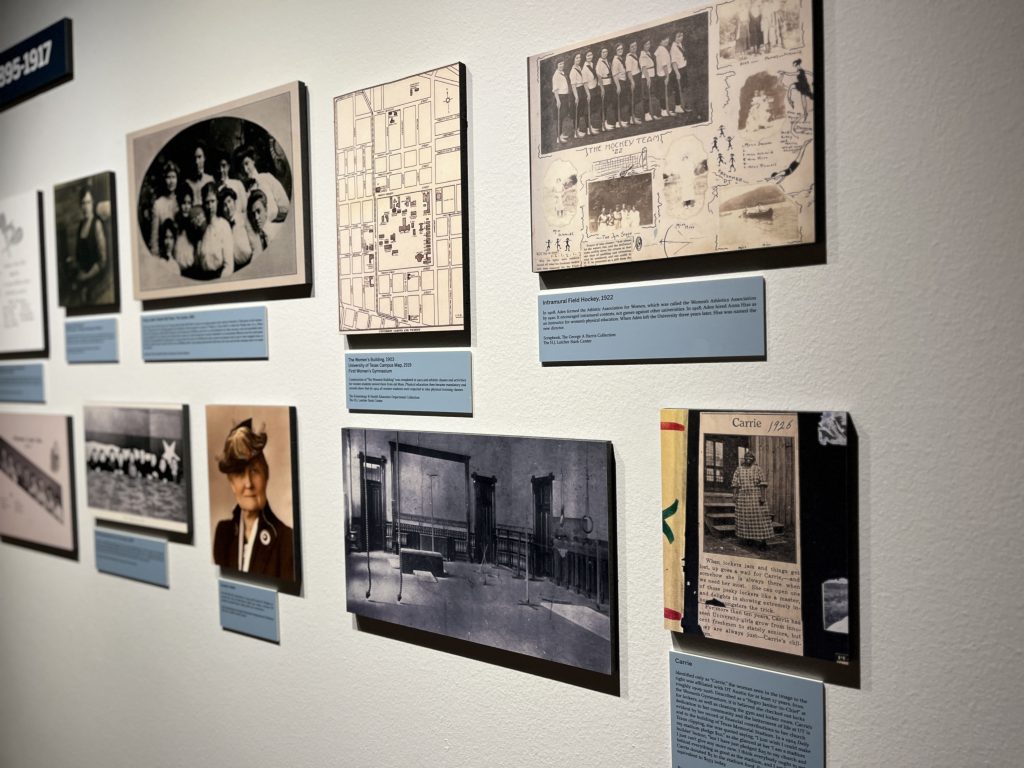
From working at the Stark Center, I was familiar with Anna Hiss, Director of Physical Training for Women from 1921 to 1957, and her wonderful collection that lives in our archives. I knew she played a colossal role in this history and that I could illustrate it with the tremendous amount of wonderful photographs of female students engaging in intramural and club sports from her collection. I was also familiar with the groundbreaking legislation of Title IX and because of the Jody Conradt exhibit I created in summer 2024, I had read about the University’s first women’s athletic director, Donna Lopiano. Suddenly, I had an outline––I had determined a beginning in the Helianthus Tennis Club, I had decided on an ending in contemporary issues surrounding Name, Image, and Likeness, and I had some ideas about pivotal figures and legislation that happened in between.
When I first met with Patty, Caroline, and Kim, we began compiling a list of “firsts” which was what Jan and I decided should be the perspective of this exhibit, a celebration of the various women firsts. With our list of firsts and a broad general history, we divided the exhibit into subsections or “eras” and then I delegated different eras to be researched in detail. In completing our research, we read through many different issues of the Cactus; sifted through articles from The Daily Texan, The Austin-American Statesman, and The Alcalde; tapped into the collections of Anna Hiss, Jody Conradt, the UT Women’s Athletics History Collection, the Texas Athletics Media Relations Collection, and the Texas Athletics Photo Archive; read the history projects of individuals like Billy Dale and his Texas Longhorn Sports Network, Jim Nicar and his UT History Corner. But especially and most importantly, former graduate student Tessa M. Nichols’ 2007 Master’s Thesis, Organizational Values and Women’s Sport at The University of Texas, 1918-1992, proved to be an invaluable guide in our work to create this exhibit.
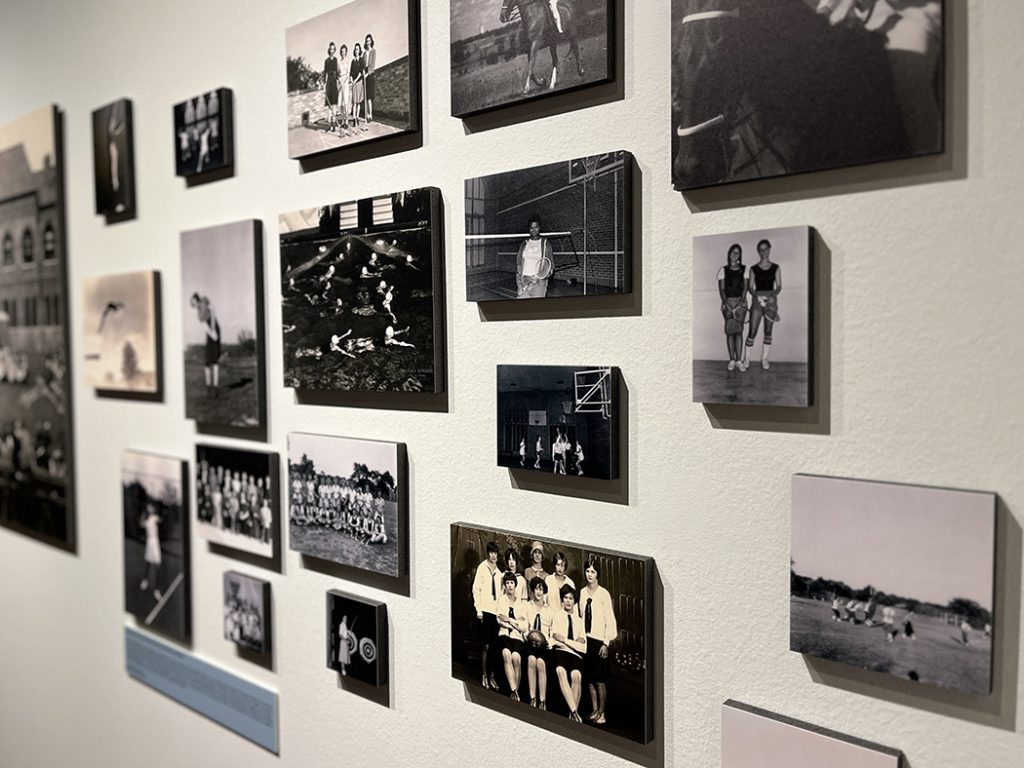
Then, we began writing the first drafts of text panels, which I later edited and pared down to individual captions. From those early texts, I was able to curate the exhibit. It’s one thing to write out a text-based history, but the next step is translating that history into a public exhibit. The challenge becomes sifting through our collections and resources to determine what photos, artifacts, documents, periodicals, sporting equipment, trophies, clothing, and other items will help me present a thorough and layered narrative. For certain parts of the story, I had a wealth of resources to work with; in others, I was severely limited. For example, in that early era before Title IX when the University approved the formation of the first intercollegiate teams, even the Cactus yearbook failed to present team photos that were distinctly identified as intercollegiate versus intramural or club. It wasn’t until 1970 that I found photographic evidence of these early teams. Once all photos and artifacts were chosen from our collections at the Stark Center, I began designing the exhibit layout in its assigned space. This means I took exact measurements of each wall in the exhibit’s designated gallery space and, while looking at the floorplan, I started to consider how I wanted the exhibit to invite and guide visitors through its herstory and which walls had the appropriate amount of square footage for the different eras. I began to think of these sections as “chapters” in the story.
Jan and I had also talked about incorporating pops of color on the gallery walls. I chose a shade of blue-green called azalea leaf. The fresh color helped me give a visual organization to the breaks between different eras in the flow of the exhibit. I also decided to add large headers to each era, giving it a title and presenting its time frame. These strategies were meant to engage as many museum visitors as possible. Exhibit designers typically think about three distinct types of visitors: 1. the speed walker, who motors through the exhibit, absorbing only what can be seen or read without breaking stride; 2. the reader, who spends the entire day at the museum, reading every publicly displayed word, sometimes twice; and 3. the in-betweener, who slowly strolls the space, stopping to consider or read select items that especially catch their attention. If you’re curious, even as a person that designs exhibits for a living, I’m a card-carrying member of the “in-betweener” category. Breaks in wall color and the large, text headers provide better opportunities for “speed walkers” to grasp the overarching narrative of the exhibit, while individual photo captions provide more specific details for members of the “reader” category. I also subscribe to the philosophy that museums are living breathing spaces and when I speak to visitors or classes of students, I ask them not to tiptoe or whisper. I urge them to ask questions and engage with each other, talk about what they see or what they think, ideally building a little bit of community in the activity. To further inspire community amongst our visitors, I incorporated an interactive segment in the exhibit.
History has not always reflected an equal value or appreciation for telling the stories of women, especially women in sport, and even more so for women of color. Especially given the time constraints, I knew that my finished exhibit was always going to be incomplete. We were able to celebrate many “firsts,” but there’s much, much more to the story. Anticipating this, I painted a section of wall with chalkboard paint and titled it “Her Story Is Often Missed.” Visitors are invited to write in any significant moment or “female first” that is not found in the exhibit. This can be their own experience, story, or known history. It might also be questions, like who were the first women to receive academic scholarships? It might acknowledge the binary nature of race in our exhibit, which is predominantly White but does include the stories of Rodney Page, the University’s first Black head coach, and Retha Swindell, the University’s first Black female athlete. But what of the Chicano Movement and Mexican-American or Latina students and coaches? How was this history experienced by persons who identify as LGBTQIA+? Not to mention the contemporary era of Name, Image, and Likeness (NIL) and the ongoing and evolving issues that the various participants of women’s athletics will face while this exhibit is open. I hope the interactive section provides a space for more stories and productive, engaging discussion.
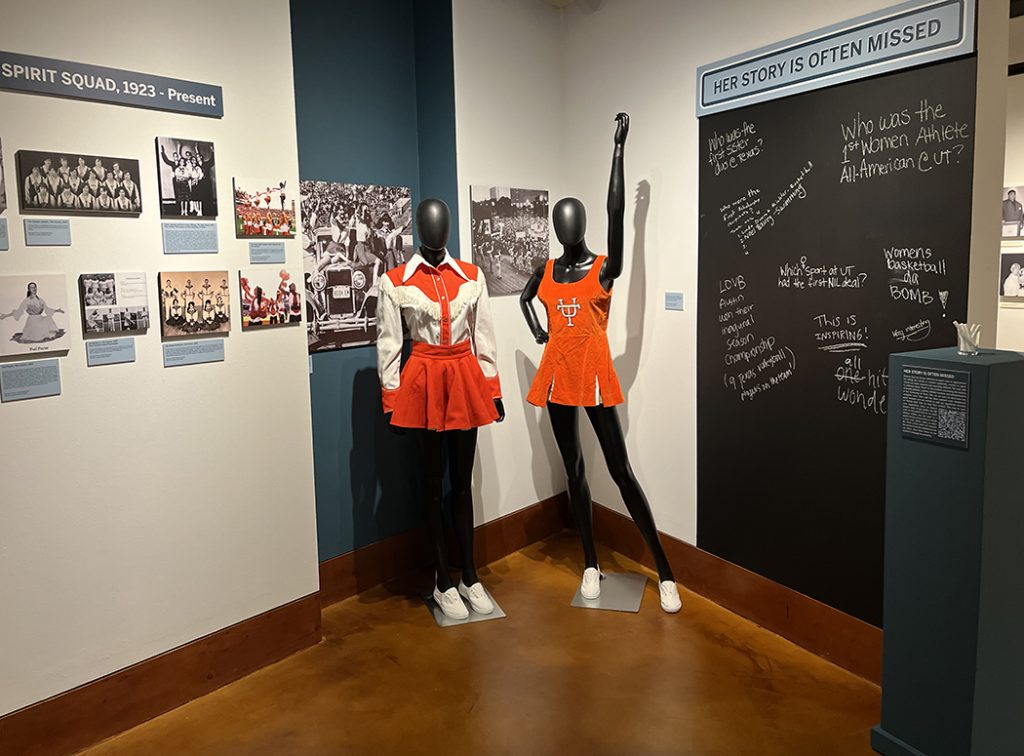
Women First! is now open and on display to the public. We’ve already had a number of graduate and undergraduate classes come through, as well as individual visitors, and we’re getting wonderful feedback and responses. I hope you’ll make time to visit us and check out the exhibit, too. If there is any way I can be of help or answer any questions, please feel free to drop by the reference desk and ask for me. If you’re not able to visit in person, but you’d like to participate in the “Her Story Is Often Missed” interactive, please send your story to info@starkcenter.org.
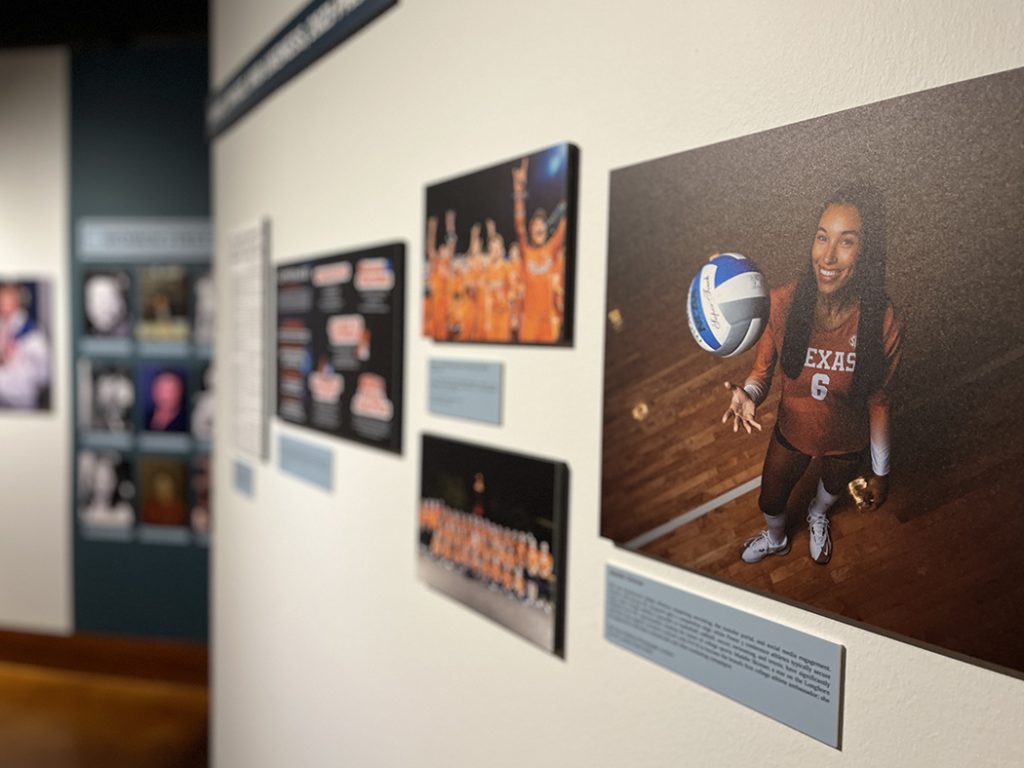


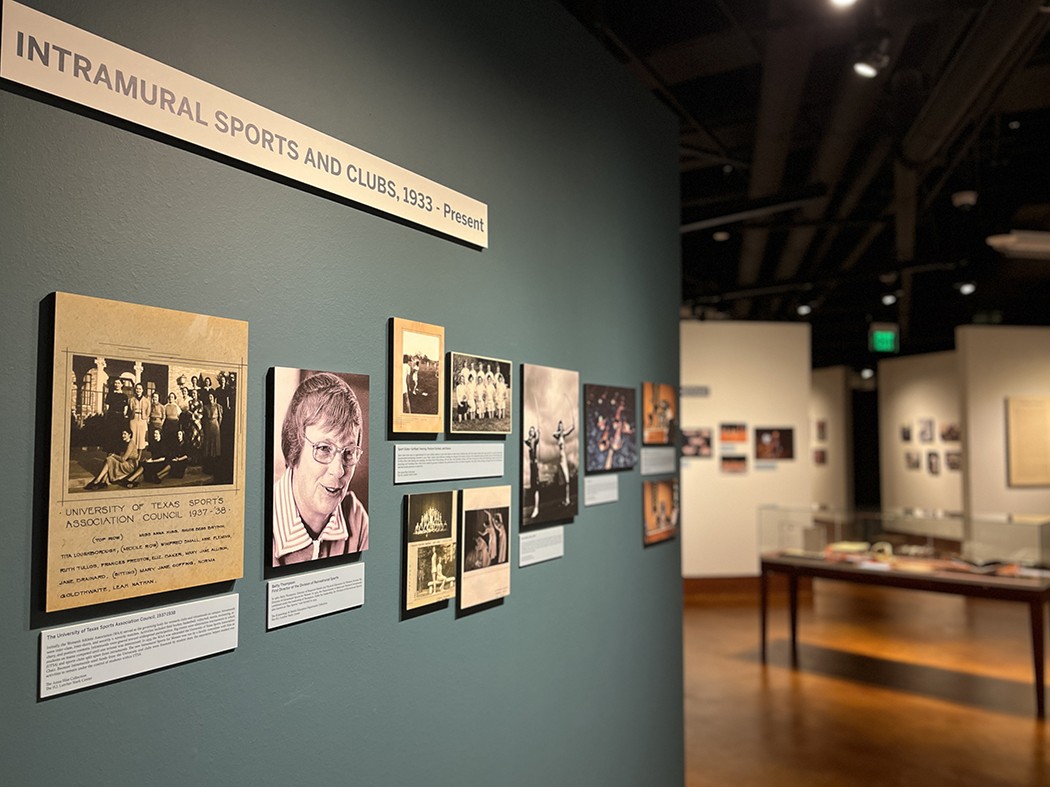

Leave a Reply